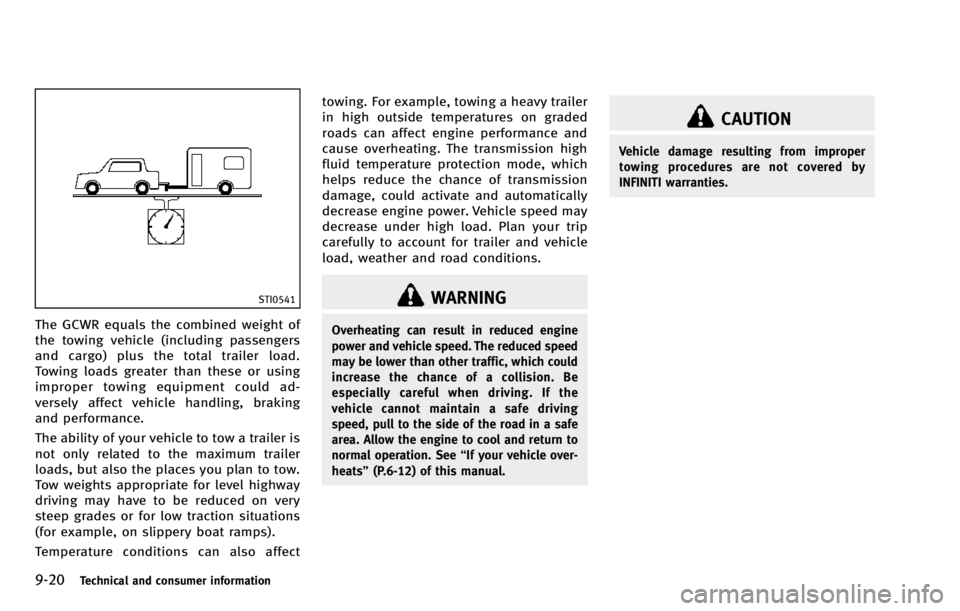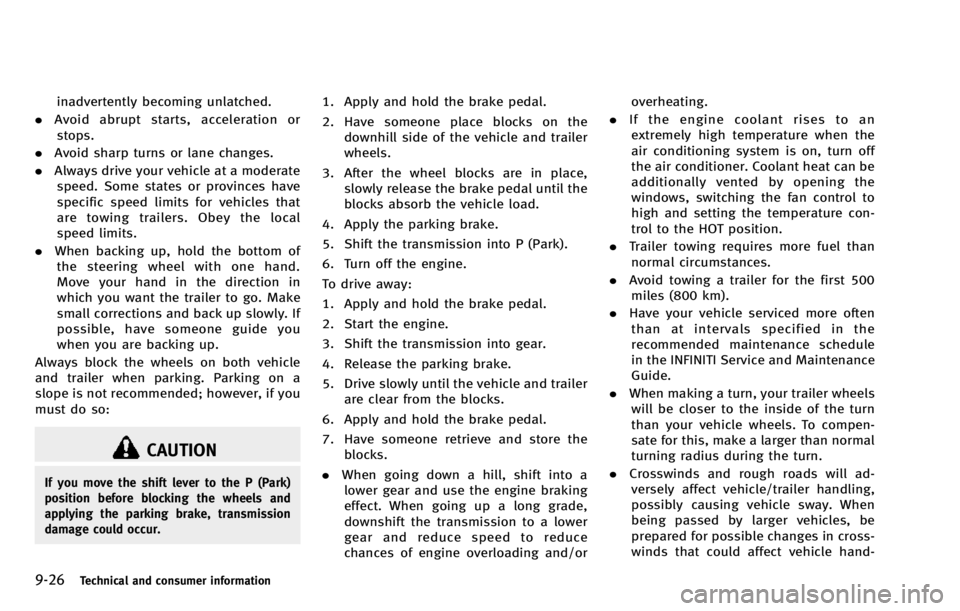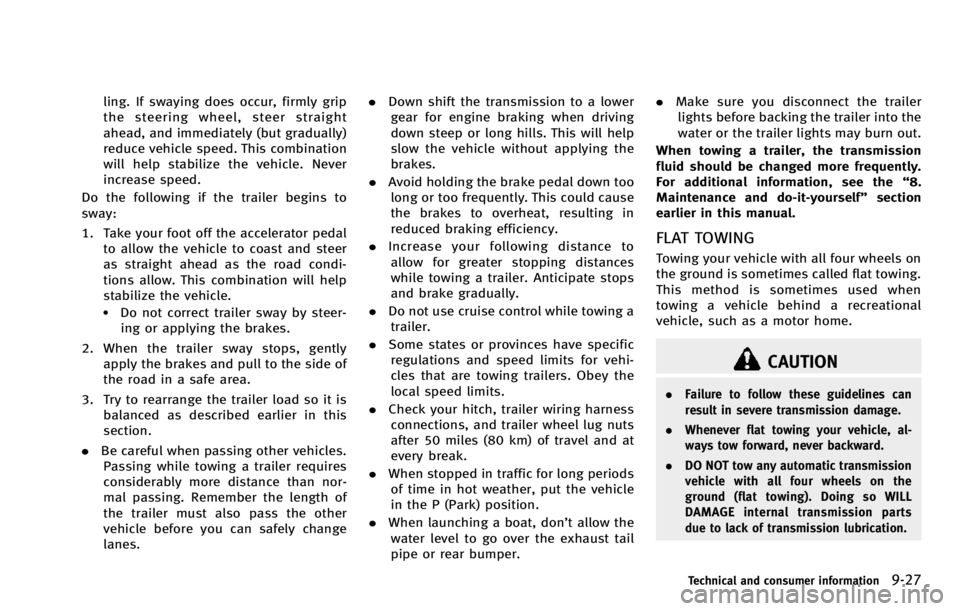Engine INFINITI QX70 2014 Owner's Manual
[x] Cancel search | Manufacturer: INFINITI, Model Year: 2014, Model line: QX70, Model: INFINITI QX70 2014Pages: 530, PDF Size: 2.48 MB
Page 494 of 530

Oil which may contain foreign matter or
has been previously used should not be
used.
Oil viscosity
The engine oil viscosity or thickness
changes with temperature. Because of this,
it is important that the engine oil viscosity
be selected based on the temperatures at
which the vehicle will be operated before
the next oil change. Choosing an oil
viscosity other than that recommended
could cause serious engine damage.
Selecting the correct oil filter
Your new vehicle is equipped with a high-
quality genuine NISSAN oil filter. When
replacing, use the genuine oil filter or its
equivalent for the reason described in
change intervals.
Change intervals
The oil and oil filter change intervals for
your engine are based on the use of the
specified quality oils and filters. Oil and
filter other than the specified quality, or oil
and filter change intervals longer than
recommended could reduce engine life.
Damage to engines caused by improper
maintenance or use of incorrect oil andfilter quality and/or viscosity is not covered
by the new INFINITI vehicle limited warran-
ties.
Your engine was filled with a high quality
engine oil when it was built. You do not
have to change the oil before the first
recommended change interval. Oil and
filter change intervals depend upon how
you use your vehicle. Operation under the
following conditions may require more
frequent oil and filter changes.
.
repeated short distance driving at cold
outside temperatures,
. driving in dusty conditions,
. extensive idling,
. towing a trailer,
. stop and go “rush hour”traffic,
Refer to the “INFINITI Service and Main-
tenance Guide” for the maintenance sche-
dule.
AIR CONDITIONING SYSTEM RE-
FRIGERANT AND LUBRICANT RE-
COMMENDATIONS
The air conditioning system in your
INFINITI vehicle must be charged with the
refrigerant HFC-134a (R-134a) and the
lubricant, NISSAN A/C system oil Type S
or the exact equivalents.
CAUTION
The use of any other refrigerant or lubricant
will cause severe damage to the air con-
ditioning system and will require the repla-
cement of all air conditioner system
components.
The refrigerant HFC-134a (R-134a) in your
INFINITI vehicle will not harm the earth’s
ozone layer. Although this refrigerant does
not affect the earth’s atmosphere, certain
governmental regulations require the re-
covery and recycling of any refrigerant
during automotive air conditioning system
service. Your INFINITI retailer has the
trained technicians and equipment needed
to recover and recycle your air conditioning
system refrigerant.
Technical and consumer information9-7
Page 495 of 530

9-8Technical and consumer information
Contact an INFINITI retailer when servicing
your air conditioning system.ENGINE
ModelVK50VEVQ37VHR
Type Gasoline, 4-cycleGasoline, 4-cycle
Cylinder arrangement 8-cylinder, V-slanted at 908
6-cylinder, V-slanted at 608
Bore 6Stroke in (mm) 3.760
63.453
(95.5 687.7) 3.760
63.385
(95.5 686.0)
Displacement cu in (cm
3) 306.7 (5,026) 225.54 (3,696)
Firing order 1-8-7-3-6-5-4-21-2-3-4-5-6
Idle speed rpm
See the emission control information label on the underside of the
hood.
Ignition timing
(B.T.D.C.)
degree/rpm
Spark plug Standard FXE22HR-11 FXE24HR-11
Spark plug gap (Normal) in (mm) 0.043 (1.1) 0.043 (1.1)
Camshaft operation Timing chainTiming chain
This spark ignition system complies with the Canadian standard ICES-002.
SPECIFICATIONS
Page 496 of 530

STI0397B
VK50VE engine
STI0425
VQ37VHR engine
WHEELS AND TIRES
Road wheel
TypeSizeOffset in (mm)
Conventional 18
68J
1.97 (50)
20
68J
21 69-1/2J
Spare 18
64-1/2T 1.18 (30)/0.98 (25)*
*: Aluminum
Tire
Type SizePressure PSI (kPa) [Cold]
Conventional P265/60R18
33 (230)
P265/50R20
P265/45R21
Spare (T-type) T175/90D18 60 (420)
Technical and consumer information9-9
Page 498 of 530

If you plan to travel in another country,
you should first find out if the fuel
available is suitable for your vehicle’s
engine.
Using fuel with too low an octane rating
may cause engine damage. All gasoline
vehicles must be operated with unleaded
gasoline. Therefore, avoid taking your
vehicle to areas where appropriate fuel is
not available.
When transferring the registration of your
vehicle to another country, state, province
or district, it may be necessary to modify
the vehicle to meet local laws and regula-
tions.
The laws and regulations for motor vehicle
emission control and safety standards vary
according to the country, state, province or
district; therefore, vehicle specifications
may differ.
When any vehicle is to be taken into
another country, state, province or district
and registered, its modifications, trans-
portation, and registration are the respon-
sibility of the user. INFINITI is not
responsible for any inconvenience that
may result.
STI0431
VEHICLE IDENTIFICATION NUMBER
(VIN) PLATE
The vehicle identification number plate is
attached as shown. This number is the
identification for your vehicle and is used
in the vehicle registration.
STI0492
VEHICLE IDENTIFICATION NUMBER
(chassis number)
The number is stamped as shown in the
engine compartment.
Technical and consumer information9-11
WHEN TRAVELING OR REGISTERING YOUR
VEHICLE IN ANOTHER COUNTRY VEHICLE IDENTIFICATION
Page 499 of 530

9-12Technical and consumer information
STI0584
VK50VE engine
STI0509
VQ37VHR engine
ENGINE SERIAL NUMBER
The number is stamped on the engine as
shown.
STI0448
F.M.V.S.S./C.M.V.S.S. CERTIFICA-
TION LABEL
The Federal/Canadian Motor Vehicle Safety
Standards (F.M.V.S.S./C.M.V.S.S.) certifica-
tion label is affixed as shown. This label
contains valuable vehicle information, such
as: Gross Vehicle Weight Ratings (GVWR),
Gross Axle Weight Rating (GAWR), month
and year of manufacture, Vehicle Identifi-
cation Number (VIN), etc. Review it care-
fully.
Page 506 of 530

serious accident and personal in-
jury. Failures caused by overload-
ing are not covered by the
vehicle’s warranty.
MEASUREMENT OF WEIGHTS
Secure loose items to prevent weight
shifts that could affect the balance of
your vehicle. When the vehicle is
loaded, drive to a scale and weigh
the front and the rear wheels sepa-
rately to determine axle loads. In-
dividual axle loads should not
exceed either of the gross axle
weight ratings (GAWR). The total of
the axle loads should not exceed the
gross vehicle weight rating (GVWR).
These ratings are given on the
vehicle certification label. If weight
ratings are exceeded, move or re-
move items to bring all weights
below the ratings.
WARNING
Overloading or improper loading of a trailer
and its cargo can adversely affect vehicle
handling, braking and performance and may
lead to accidents.
CAUTION
.Do not tow a trailer or haul a heavy load
for the first 500 miles (800 km). Your
engine, axle or other parts could be
damaged.
. For the first 500 miles (800 km) that you
tow a trailer, do not drive over 50 MPH
(80 km/h) and do not make starts at full
throttle. This helps the engine and other
parts of your vehicle wear in at the
heavier loads.
Your new vehicle was designed to be used
primarily to carry passengers and cargo.
Remember that towing a trailer places
additional loads on your vehicle’s engine,
drivetrain, steering, braking and other
systems. An INFINITI Towing Guide (U.S. only) is
available on the website at www.InfinitiU-
SA.com. This guide includes information on
trailer towing capability and the special
equipment required for proper towing.
MAXIMUM LOAD LIMITS
Maximum trailer loads
Never allow the total trailer load to exceed
the value specified in the
“Towing Load/
Specification” chart. The total trailer load
equals trailer weight plus its cargo weight.
. When towing a trailer load of 1,000 lbs
(454 kg) or more, trailers with a brake
system MUST be used.
The maximum GCWR (Gross Combined
Weight Rating) should not exceed the value
specified in the following “Towing Load/
Specification” chart.
Technical and consumer information9-19
TOWING A TRAILER
Page 507 of 530

9-20Technical and consumer information
STI0541
The GCWR equals the combined weight of
the towing vehicle (including passengers
and cargo) plus the total trailer load.
Towing loads greater than these or using
improper towing equipment could ad-
versely affect vehicle handling, braking
and performance.
The ability of your vehicle to tow a trailer is
not only related to the maximum trailer
loads, but also the places you plan to tow.
Tow weights appropriate for level highway
driving may have to be reduced on very
steep grades or for low traction situations
(for example, on slippery boat ramps).
Temperature conditions can also affecttowing. For example, towing a heavy trailer
in high outside temperatures on graded
roads can affect engine performance and
cause overheating. The transmission high
fluid temperature protection mode, which
helps reduce the chance of transmission
damage, could activate and automatically
decrease engine power. Vehicle speed may
decrease under high load. Plan your trip
carefully to account for trailer and vehicle
load, weather and road conditions.
WARNING
Overheating can result in reduced engine
power and vehicle speed. The reduced speed
may be lower than other traffic, which could
increase the chance of a collision. Be
especially careful when driving. If the
vehicle cannot maintain a safe driving
speed, pull to the side of the road in a safe
area. Allow the engine to cool and return to
normal operation. See
“If your vehicle over-
heats” (P.6-12) of this manual.
CAUTION
Vehicle damage resulting from improper
towing procedures are not covered by
INFINITI warranties.
Page 513 of 530

9-26Technical and consumer information
inadvertently becoming unlatched.
. Avoid abrupt starts, acceleration or
stops.
. Avoid sharp turns or lane changes.
. Always drive your vehicle at a moderate
speed. Some states or provinces have
specific speed limits for vehicles that
are towing trailers. Obey the local
speed limits.
. When backing up, hold the bottom of
the steering wheel with one hand.
Move your hand in the direction in
which you want the trailer to go. Make
small corrections and back up slowly. If
possible, have someone guide you
when you are backing up.
Always block the wheels on both vehicle
and trailer when parking. Parking on a
slope is not recommended; however, if you
must do so:
CAUTION
If you move the shift lever to the P (Park)
position before blocking the wheels and
applying the parking brake, transmission
damage could occur.
1. Apply and hold the brake pedal.
2. Have someone place blocks on the downhill side of the vehicle and trailer
wheels.
3. After the wheel blocks are in place, slowly release the brake pedal until the
blocks absorb the vehicle load.
4. Apply the parking brake.
5. Shift the transmission into P (Park).
6. Turn off the engine.
To drive away:
1. Apply and hold the brake pedal.
2. Start the engine.
3. Shift the transmission into gear.
4. Release the parking brake.
5. Drive slowly until the vehicle and trailer are clear from the blocks.
6. Apply and hold the brake pedal.
7. Have someone retrieve and store the blocks.
. When going down a hill, shift into a
lower gear and use the engine braking
effect. When going up a long grade,
downshift the transmission to a lower
gear and reduce speed to reduce
chances of engine overloading and/or overheating.
. If the engine coolant rises to an
extremely high temperature when the
air conditioning system is on, turn off
the air conditioner. Coolant heat can be
additionally vented by opening the
windows, switching the fan control to
high and setting the temperature con-
trol to the HOT position.
. Trailer towing requires more fuel than
normal circumstances.
. Avoid towing a trailer for the first 500
miles (800 km).
. Have your vehicle serviced more often
than at intervals specified in the
recommended maintenance schedule
in the INFINITI Service and Maintenance
Guide.
. When making a turn, your trailer wheels
will be closer to the inside of the turn
than your vehicle wheels. To compen-
sate for this, make a larger than normal
turning radius during the turn.
. Crosswinds and rough roads will ad-
versely affect vehicle/trailer handling,
possibly causing vehicle sway. When
being passed by larger vehicles, be
prepared for possible changes in cross-
winds that could affect vehicle hand-
Page 514 of 530

ling. If swaying does occur, firmly grip
the steering wheel, steer straight
ahead, and immediately (but gradually)
reduce vehicle speed. This combination
will help stabilize the vehicle. Never
increase speed.
Do the following if the trailer begins to
sway:
1. Take your foot off the accelerator pedal to allow the vehicle to coast and steer
as straight ahead as the road condi-
tions allow. This combination will help
stabilize the vehicle.
.Do not correct trailer sway by steer-ing or applying the brakes.
2. When the trailer sway stops, gently apply the brakes and pull to the side of
the road in a safe area.
3. Try to rearrange the trailer load so it is balanced as described earlier in this
section.
. Be careful when passing other vehicles.
Passing while towing a trailer requires
considerably more distance than nor-
mal passing. Remember the length of
the trailer must also pass the other
vehicle before you can safely change
lanes. .
Down shift the transmission to a lower
gear for engine braking when driving
down steep or long hills. This will help
slow the vehicle without applying the
brakes.
. Avoid holding the brake pedal down too
long or too frequently. This could cause
the brakes to overheat, resulting in
reduced braking efficiency.
. Increase your following distance to
allow for greater stopping distances
while towing a trailer. Anticipate stops
and brake gradually.
. Do not use cruise control while towing a
trailer.
. Some states or provinces have specific
regulations and speed limits for vehi-
cles that are towing trailers. Obey the
local speed limits.
. Check your hitch, trailer wiring harness
connections, and trailer wheel lug nuts
after 50 miles (80 km) of travel and at
every break.
. When stopped in traffic for long periods
of time in hot weather, put the vehicle
in the P (Park) position.
. When launching a boat, don’t allow the
water level to go over the exhaust tail
pipe or rear bumper. .
Make sure you disconnect the trailer
lights before backing the trailer into the
water or the trailer lights may burn out.
When towing a trailer, the transmission
fluid should be changed more frequently.
For additional information, see the “8.
Maintenance and do-it-yourself” section
earlier in this manual.
FLAT TOWING
Towing your vehicle with all four wheels on
the ground is sometimes called flat towing.
This method is sometimes used when
towing a vehicle behind a recreational
vehicle, such as a motor home.
CAUTION
. Failure to follow these guidelines can
result in severe transmission damage.
. Whenever flat towing your vehicle, al-
ways tow forward, never backward.
. DO NOT tow any automatic transmission
vehicle with all four wheels on the
ground (flat towing). Doing so WILL
DAMAGE internal transmission parts
due to lack of transmission lubrication.
Technical and consumer information9-27
Page 518 of 530

WARNING
A vehicle equipped with All-Wheel Drive
(AWD) should never be tested using a two
wheel dynamometer (such as the dynam-
ometers used by some states for emissions
testing), or similar equipment. Make sure
you inform test facility personnel that your
vehicle is equipped with AWD before it is
placed on a dynamometer. Using the wrong
test equipment may result in transmission
damage or unexpected vehicle movement
which could result in serious vehicle da-
mage or personal injury.
Due to legal requirements in some states/
areas or provinces, your vehicle may be
required to be in what is called the“ready
condition” for an Inspection/Maintenance
(I/M) test of the emission control system.
The vehicle is set to the “ready condition”
when it is driven through certain driving
patterns. Usually, the “ready condition”
can be obtained by ordinary usage of the
vehicle.
If a powertrain system component is
repaired or the battery is disconnected,
the vehicle may be reset to a “not readycondition”
. Before taking the I/M test,
check the vehicle’ s inspection/mainte-
nance test readiness condition. Place the
ignition switch in the ON position without
starting the engine. If the Malfunction
Indicator Light (MIL) comes on steady for
20 seconds and then blinks for 10
seconds, the I/M test condition is “not
ready”. If the MIL does not blink after 20
seconds, the I/M test condition is “ready”.
Contact an INFINITI retailer to set the
“ready condition” or to prepare the vehicle
for testing. This vehicle is equipped with an Event Data
Recorder (EDR). The main purpose of an
EDR is to record, in certain crash or near
crash-like situations, such as an air bag
deployment or hitting a road obstacle, data
that will assist in understanding how a
vehicle’s systems performed. The EDR is
designed to record data related to vehicle
dynamics and safety systems for a short
period of time, typically 30 seconds or
less. The EDR in this vehicle is designed to
record such data as:
.
How various systems in your vehicle
were operating;
. Whether or not the driver and passen-
ger safety belts were buckled/fastened;
. How far (if at all) the driver was
depressing the accelerator and/or
brake pedal; and,
. How fast the vehicle was traveling.
. Sounds are not recorded.
These data can help provide a better
understanding of the circumstances in
which crashes and injuries occur.
NOTE: EDR data are recorded by your
vehicle only if a nontrivial crash situation
occurs; no data are recorded by the EDR
under normal driving conditions and no
personal data (e.g. name, gender, age and
Technical and consumer information9-31
READINESS FOR INSPECTION/
MAINTENANCE (I/M) TEST EVENT DATA RECORDERS (EDR)